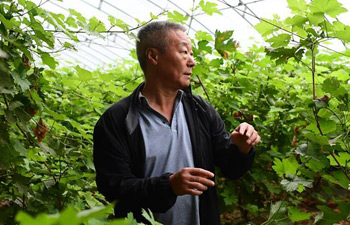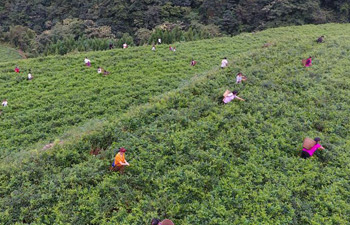NAIROBI, Sept. 8 (Xinhua) -- Scientists from a global invasive species organization on Friday warned a parasitic invasive weed known as Cuscuta is threatening the survival of crops and biodiversity in western Kenya.
Arne Witt, coordinator of Invasive Species at the UK-based Center for Agriculture and Biosciences International (CABI), noted that the weed is currently spreading at an alarming rate, spreading into other plants thus suffocating them.
"The biodiversity and livelihoods is threatened as the weed only dries out when the host plant dies," Witt told Xinhua in Nairobi.
The scientist said that the weed that is yellowish in color often leads to total crop failure hence causing untold sufferings to farmers in western Kenya.
He noted that once it gets into contact with the host phloem, cuscuta causes a severe drain on host resources and often completely preventing normal fruit development as it depends almost entirely on the host for growth and survival.
"The government must come up with measures to help manage the weed or else it will remain one of the causes of food insecurity in the country," he added.
Commonly known as field dodder, the weed is found on a wide variety of hosts in Kenya in farms, bushy and waste places and forests. Lately, it has been ravaging people's fences.
Witt however said that farmers can help keep it off their farms only if they plant clean seeds from reliable sources.
"The hosts around farms, forest and homes should also be removed to help stop it from spreading to other regions," he added.
MaryLucy Oronje, CABI's Plantwise Knowledge Bank Coordinator for East Africa, confirmed that the weed is fast spreading into the region, hence the need to develop measures against its spread.
"The weed is apparently getting into the Kakamega forest in western Kenya edges and is moving in the forest," Oronje said.
She noted that Kakamega forest's abundant birds and primate of many species are threatened by the weed that will eventually lead to the escalation of human wildlife conflict and loss of revenue from the tourists that visit the forest on a daily basis.
Eastern Africa has many indigenous species and all have similar impacts as they all look very similar and are hard to tell apart.
Cuscuta campestris is abundant in Kakamega Forest is assumed to be native subject to formal confirmation.
She recommends rotation with non-susceptible crops since cereals are virtually immune from attack, and some broad-leaved crops may also be sufficiently resistant, including soyabean, kidney bean, squash, cucumber and cotton.
Vincent Ouma, a farmer in Homa Bay County the invasive weed has become increasingly problematic in the region as it is becoming much more widespread and abundant than indicated.
"The weed has brought down my fence and I am still weighing options before fencing afresh," he added.
The parasitic weed is native to North America but has been introduced around the world and becomes a weed in many countries.
It germinates regardless of light or darkness and its seeds are believed to persist for up to 10 years in the soil.
Vegetative spread can occur through the extensive growth of stems which can reach up to five meters in just two months, but regeneration can also occur from stem fragments which are detached and distributed intentionally or otherwise by man, animals or machinery.
According to the scientists, a range of soil-acting herbicides are effective in preventing the germination and establishment of the weed but short soil persistence meant that it rarely provided suppression for long enough.

















